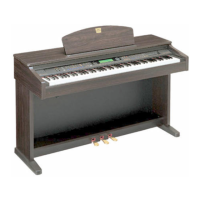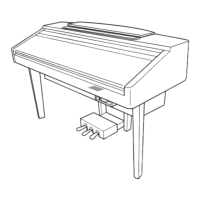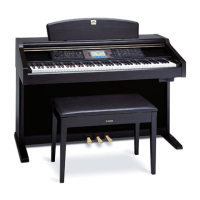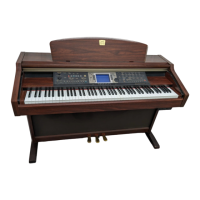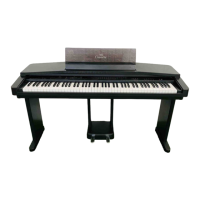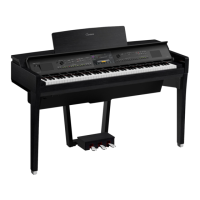Do you have a question about the Yamaha Clavinova CVP-25 and is the answer not in the manual?
Ensure local AC mains voltage matches the product's specified voltage for safe operation.
Explains safety labels, battery disposal, and environmental product considerations.
Covers product testing, modification policies, specification changes, and name plate details.
Covers reading manuals, power verification, plug usage, and extension cords.
Guidelines on ventilation, temperature, location, and servicing by qualified personnel.
Addresses electrical shock risks, tampering, and potential hearing damage from high volumes.
Highlights AWM, polyphony, touch sensitivity, split play, and MIDI functions.
Lists the chapters and page numbers for navigating the owner's manual.
Advice on avoiding humidity, heat, dust, and proper handling to prevent damage.
Instructions on power-off, avoiding tampering with internal circuitry, and power supply checks.
Explains data retention and using the Bulk Dump function for long-term storage.
Diagram identifying numbered controls on the main keyboard panel.
Identifies connectors and jacks found on the rear and bottom panels.
Details on power, volume, demo, reverb, MIDI/transpose, and accompaniment controls.
Explains voice selectors, split button, and related functions.
Lists headphone jack, auxiliary outputs, and other essential controls.
Instructions for setting up the music stand and powering the unit on/off.
Guidance on plugging in headphones for private practice sessions.
How to control the overall sound volume for speakers and headphones.
Adjusting volume levels for rhythm, chord 1, chord 2, and bass parts.
Details the amplifier and speaker system of the Clavinova.
How to choose, play, and stop the built-in demonstration tunes.
Lists composers and song titles for the available demonstration pieces.
Direct access to panel voices via selectors and using buttons for 1-128 voices.
Categorized list of all 128 internal voices with names and MIDI program numbers.
Lists voices in the Reed, Synth Lead, Synth Pad, and Synth Effects categories.
Lists Percussive/Sound Effects voices and the mapping of panel voices to internal voices.
How to use the DRUMS voice to play percussion instruments on the keyboard.
Table mapping keyboard keys to specific drum and percussion instruments.
How to activate Split Mode and change voices for left/right sections.
Procedure to adjust the key that divides the keyboard into left and right sections.
How the damper pedal affects left voice only, right voice only, or both voices.
Details the functions of the left pedal: Soft, Start/Stop, and Solo Styleplay.
How to choose and activate reverb effects like ROOM, HALL, and COSMIC.
Controlling the intensity or depth of the selected reverb effect.
Explains the maximum polyphony and how voice usage affects it.
Categorized list of all 128 internal voices with names and MIDI program numbers.
Further details on internal voices, including special notes on usage and ranges.
Settings to control how key velocity affects volume/timbre, including 'off' mode.
Describes the sustain function of the damper pedal.
Details the Soft, Start/Stop, and Solo Styleplay functions of the left pedal.
Shifting the entire keyboard's pitch up or down in semitones.
Adjusting the overall pitch in cents for tuning with other instruments.
How to choose from 99 styles using selectors and buttons.
Adjusting the tempo for selected accompaniment styles.
Details styles from Pop, Dance, and Disco categories with rhythm and comments.
Details styles from Rhythm & Blues and Rock categories with rhythm and comments.
Details styles from Rock & Roll, Traditional Jazz, and Contemporary Jazz categories.
Details styles from Latin, Caribbean, and Country & Western categories.
Details styles from World Music and Ballroom categories.
Correlates panel style selectors to their corresponding style numbers (1-99).
How to adjust the tempo for selected accompaniment styles.
Procedures for Straight Start and Start with Introduction.
Using synchronized start and automatic fill-ins for accompaniment.
How to stop the accompaniment using START/STOP or INTRO/ENDING buttons.
How to activate and use the metronome, including volume control.
Producing accompaniment using simple fingerings for major, minor, and seventh chords.
How to form minor, seventh, and minor-seventh chords with specific key presses.
Using the Fingered mode to supply your own chords for accompaniment.
Lists the various chord types recognized by the Clavinova.
Using the entire keyboard to detect chords for accompaniment.
Important notes on chord recognition, inversions, and mode interactions.
Adjusting volumes for rhythm, chords, and bass in ABC mode.
Procedure to set or reset the split point for ABC chord detection.
How to turn on Solo Styleplay, select styles, set tempo, and play melody/chords.
Using the left pedal to control Solo Styleplay harmonization of right-hand notes.
Information on data backup and memory limits for solo recordings.
Step-by-step guide to recording and playing back solo musical performances.
How to stop recording and playback of solo performances.
Integrating the metronome with solo recording for timing accuracy.
Guide to setting features and recording performances with auto accompaniment.
How to play back recorded performances that include solo and accompaniment parts.
Explanation of MIDI interface for connecting and controlling musical instruments.
Setting MIDI transmit channels for right and left keyboard sections.
Controlling whether the keyboard triggers internal sounds or external MIDI devices.
Choosing MIDI clock source and transmitting Performance Memory data.
Details of MIDI messages transmitted and recognized by the Clavinova CVP-25.
Specifics on control change, program change, and system messages.
Details on chart entries like channel pressure, bank select, and GM System Level 1.
Explanations for exclusive messages, clock selection, and GM System Level 1 compliance.
Connectors for external synthesizers or tone generator modules.
Jacks for connecting to amplifiers, mixers, or recording equipment.
Ports for connecting MIDI devices for control and data transfer.
Solutions for problems like no sound, or no rhythm/ABC/memory sound.
Troubleshooting advice for radio/TV interference and distorted audio.
Diagrams showing the parts and screws required for keyboard stand assembly.
Steps 1-3 cover opening the box, assembling side panels/feet, and attaching the center panel.
Steps 4-5 detail attaching the pedal box and installing the main keyboard unit.
Procedure for connecting the pedal cord to the main unit.
Adjusting the pedal box feet for stable operation and proper effect control.
Specs for keyboard, tone generator, voice selectors, ABC, and styles.
Details on performance memory, pedals, controls, and jacks/connectors.
Specs for audio output, speakers, dimensions, and weight.
Details on FCC regulations for digital devices and interference prevention.
Import notices for various countries and mains plug wiring instructions.
| Type | Digital Piano |
|---|---|
| Number of Keys | 88 |
| Sound Source | AWM (Advanced Wave Memory) |
| Effects | Reverb, Chorus |
| Demo Songs | Yes |
| Amplifier | 20W x 2 |
| Keyboard Action | Graded Hammer Effect |
| Touch Sensitivity | Yes |
| Polyphony | 32 |
| Pedals | Damper, Soft, Sostenuto |
| Connectivity | Headphone |
| Included Accessories | Bench |


